Analyzing Intel Core M Performance: How 5Y10 can beat 5Y71 & the OEMs' Dilemma
by Brett Howse & Ian Cutress on April 8, 2015 8:00 AM ESTTouchXPRT 2014 Results
TouchXPRT performs several tasks, and the workloads very much fall into the race to sleep category. There are several workloads, from adding filters to photos, to creating podcasts. The benchmark takes about ten minutes to complete, but each workload is slightly different.
Looking at the Core i5 graph makes it very obvious where the heaviest lifting is in this benchmark, but even that one is full of bursts of work. The Dell Venue tablet is able to hit a very high frequency for many of these tasks, since it has adequate time to cool off in between. The ASUS is as consistent as always, and the Yoga 3 Pro can really stretch its legs on this benchmark.
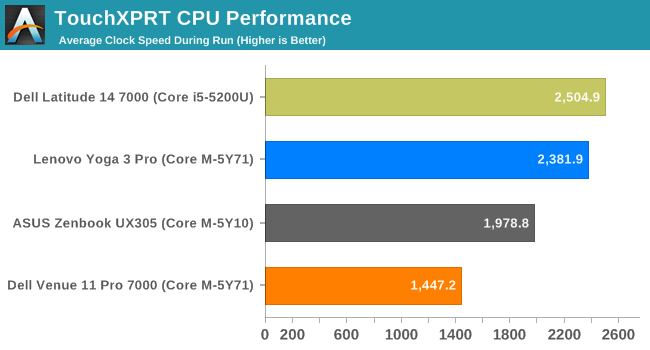
Looking at the average CPU frequency, the Yoga 3 Pro beats out the other Core M devices by a lot, and even turbo higher than the Core i5 on many occasions. If the work is short, the higher burst frequency of the 5Y71 can make a big difference. This would be very similar to web browsing, where short bursts of work get the job done. The Dell has the lowest average CPU frequency again, but as we have seen in previous results the fact that it can hit a much higher frequency than the ASUS can help it regain ground, especially on a short workload such as this one.
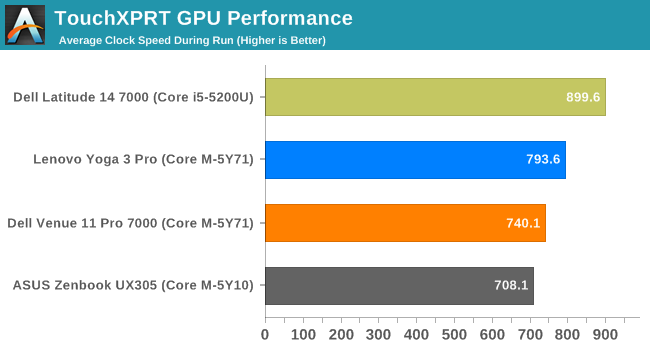
The GPU average frequencies show the disadvantage of the 5Y10. It is quite a bit under the 800 MHz turbo frequency of the chip, and it cannot turbo to the 900 MHz of the other two chips when it does have thermal headroom to make up the difference. The other two devices can be seen to jump all the way up to the 900 MHz maximum many times.

Temperatures are low, and the ASUS is the lowest again. The Yoga 3 Pro is sitting right at the 65°C target temperature, which means it was not always able to keep within that target during these quick bursts of energy needed.
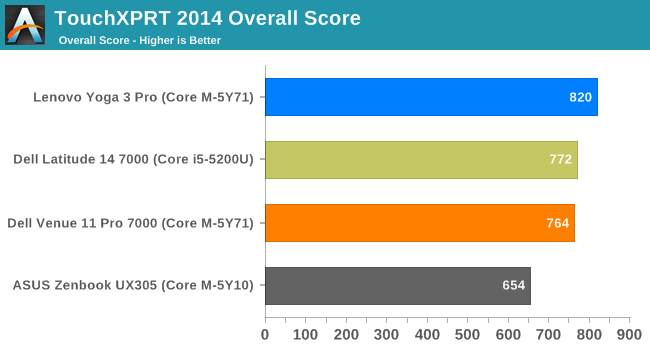
TouchXPRT is almost a perfect workload for 5Y71, and the Yoga 3 Pro outperforms even the Core i5-5200U in this test. The Venue 11 Pro also comes in right at the score of the Core i5. The ASUS UX305 is certainly hampered by its lack of turbo compared to the other devices in this test. It had the lowest average temperature, and it could not do anything with it.



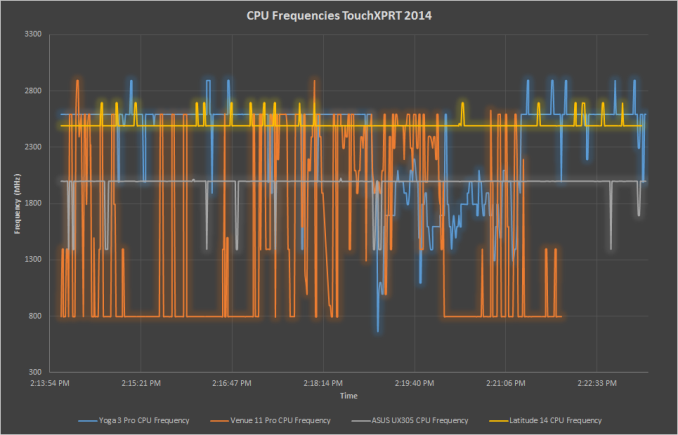
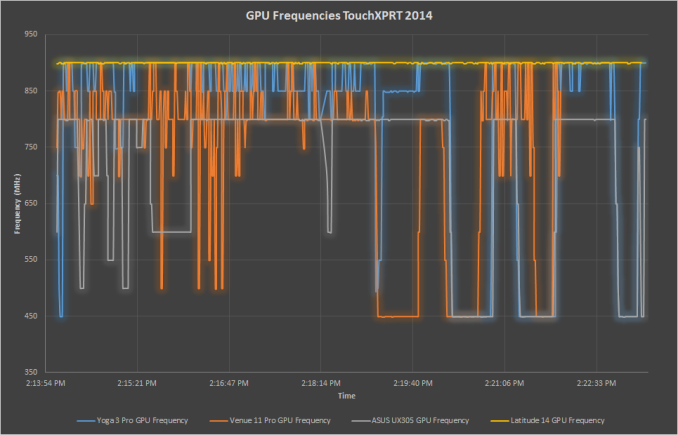
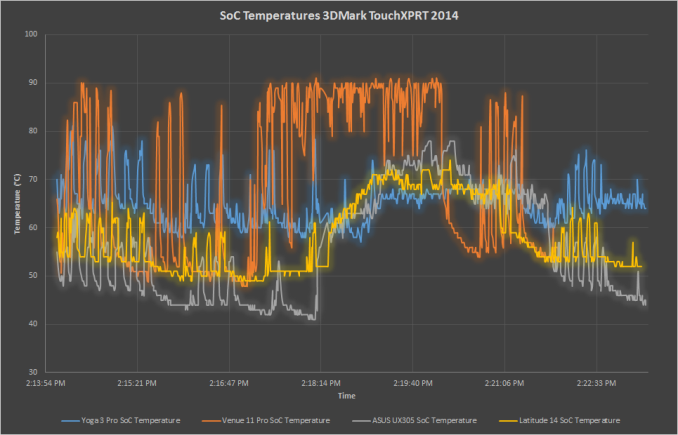








110 Comments
View All Comments
serendip - Wednesday, April 8, 2015 - link
Core M is expensive for what it does. If you want mobility without a fan, go with Atom. If you want better unthrottled performance, go with the U models.It's the weird throttling and poor OEM thermal designs which concern me. Core M may have good turbo speeds but that's useless if it has to throttle down quickly from heat soak. Users will be disappointed when their machines act speedy one moment and start lagging the next, no matter what the design turbo speeds are.
serendip - Wednesday, April 8, 2015 - link
Can't edit comments, sigh. Anyway, my Bay Trail Atom tablet runs from 600 MHz to 1.86 GHz and has no issues with thermal throttling. It can smoothly turbo and then clock down without dropping down too far and sacrificing usability.It seems some OEMs like Lenovo set a total system power draw limit that's too low, on top of skin thermal limits. The CPU can only turbo for very short periods of time before being dropped to base speed or even lower. You're then stuck with a 1 GHz CPU and 100 MHz GPU which you paid a ton of money for. I think the problem lies with both sloppy engineering from OEMs and unrealistic promises made by Intel.
nonoverclock - Wednesday, April 8, 2015 - link
I have a Bay Trail Atom (Venue Pro 11) and it's alright but I definitely need more speed. Trying to stream sports games through their Metro apps will often skip and this doesn't happen on my higher performance devices. Also it has some inexplicable pauses here and there. More speed would be great.Brett Howse - Wednesday, April 8, 2015 - link
I think you are missing the fact that even throttled Broadwell is a lot faster than Silvermont cores. I don't have the T100 in the notebook bench (it is a tablet) but the HP Stream has two Silvermont cores and a 7.5 watt TDP http://anandtech.com/bench/product/1449?vs=1400If you want to compare to quad-core Bay Trail some of the scores are here http://anandtech.com/show/7428/asus-transformer-bo...
Bay Trail was a big boost for Atom but I would take Core M in a mobile device over it any day.
Pissedoffyouth - Thursday, April 9, 2015 - link
My bay trail Asus T100 never throttles back from 1.8ghz even under prime95+furmark. very power efficientsonicmerlin - Wednesday, April 8, 2015 - link
I really like this article, but I wish you had run GFXBench, which is more of a pure GPU test. I want to compare the results to the iPad's A8X and Tegra K1.Brett Howse - Wednesday, April 8, 2015 - link
I have discussed this in the actual device reviews. This article wasn't about that kind of comparison so I will ask you to go to the review http://anandtech.com/show/9104/asus-zenbook-ux305-...testbug00 - Wednesday, April 8, 2015 - link
All this testing, and, I don't see a single power system power draw number for anything. Maybe I'm missing something? But, woudn't seeing the i5 system draw 7-13 watts more be useful for determining how good Core M is?If the product uses a third of the power and gets 50-100% of the performance... Well. That's very impressive.
Alexvrb - Wednesday, April 8, 2015 - link
Do you like phystics? Do you like phystics in your mouth? (typo on page 2!)Brett Howse - Thursday, April 9, 2015 - link
TYVM :)